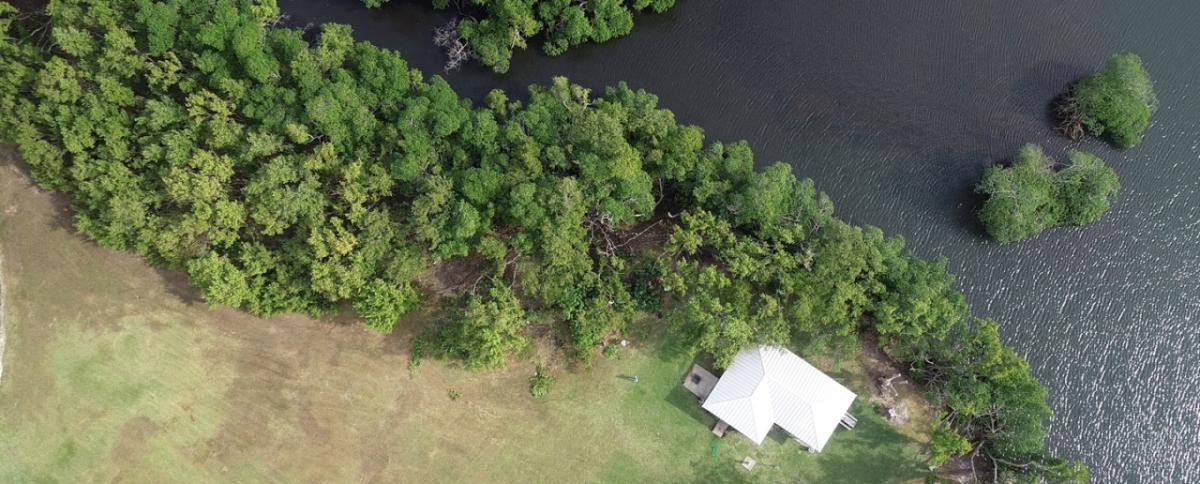How One Community Kept a Hurricane at Bay
The Phillip and Patricia Frost Museum of Science is restoring coastal wetlands and dune habitats in Florida, thanks to grants from Wells Fargo and the National Fish and Wildlife Foundation.

How One Community Kept a Hurricane at Bay
When Hurricane Irma made landfall in the Florida Keys in 2017, many beaches were diminished by high winds and ocean activity. But when Irma struck Virginia Key, a barrier island in Miami, a dune replanted there by the Phillip and Patricia Frost Museum of Science — and more than 3,000 volunteers — kept out the surge.
Work on the dune started in 2013 through a joint effort with Miami-Dade County’s Department of Environmental Resource Management and The City of Miami. It was funded by an approximately $99,000 grant to the museum through Wells Fargo and the National Fish and Wildlife Foundation’s former Environmental Solutions for Communities grant program to bring back coastal habitats so they could provide food and shelter for native organisms, and increase coastal green space for the growing city. By planting native plants and eliminating invasive species, the staff and volunteers not only restored part of the barrier island, but when Hurricane Irma made its appearance, the native plants’ deep roots repelled sea surge and helped trap the sand, expanding the width of the coastline.
“What we’ve done is cheaper than sea walls and gray concrete infrastructure,” said Fernando Bretos, director of marine conservation for the museum. “And it’s green and more sustainable. Sea walls are effective for only so long. Mangroves and dunes stick around.”
Based on that success, museum staff and volunteers are continuing their work to restore 17 acres of coastal wetlands and dune habitats at three sites in Miami-Dade County, thanks to a Wells Fargo and National Fish and Wildlife Foundation Resilient Communities Program grant of more than $287,000. Frost Science is matching that grant with $392,000, for a total impact of approximately $680,000. The four-year Resilient Communities Program was launched in 2017 and provides grants to improve freshwater quality and quantity, advance forest health, and mitigate the impacts of sea level rise. The grants help communities become more resilient in the face of conditions associated with a changing climate. Wells Fargo is providing $12.4 million for the program, which will be used to leverage other private and public matching funds.
“Every year Wells Fargo donates millions of dollars to help communities respond to the devastation caused by climate-related events such wildfires, flooding, and hurricanes,” said Stephanie Rico of Wells Fargo Sustainability and Corporate Responsibility. “With this program, we are being proactive by investing in existing natural infrastructure to fortify natural defenses like Florida’s barrier islands and helping communities build capacity to prepare for and better respond to increasingly destructive climate-related events.”
‘It’s time to give back’
In December 2018, volunteers from Wells Fargo and Frost Science removed invasive species, including seaside mahoe and Brazilian pepper trees, from East Greynolds Park in Miami, a new restoration site overseen by Miami-Dade County, and prepared the area for native saltwater wetland plantings.
“Frost Science is grateful to Wells Fargo for its steadfast commitment to enhancing the resiliency of our coastline in Greater Miami — not only through a financial commitment, but through the eager participation of Wells Fargo Green Team volunteers,” Bretos said. “By working so hard at East Greynolds Park, we are bringing back mangrove wetlands, one of the most valuable subtropical native buffers. In addition to providing natural habitat above and below the water line for a myriad of native organisms, their woody roots and trunks serve as a formidable natural defense to tropical storms and rising sea levels.”
Mike Rasco, a senior business relationship manager for Wells Fargo and the head of the company’s South Florida Green Team, was one of the volunteers who participated in the December 2018 event. He has volunteered with the museum for more than six years and donates mangroves to the museum.
“I like to give back, and I love the beach,” Rasco said. “Volunteering with the Frost Museum is like a vacation. The work they do is very important. Many of the mangroves here in South Florida and the Florida Keys have been wiped out. It’s time to give back. It’s really wonderful that Wells Fargo gives back to the museum, too. The fact that they give back to my area really makes a difference.”
Most of the Resilient Communities grant will support work involving planting native species, but the museum is also using funding for exhibits about coastal ecology and for local youth to make a documentary about sea level rise.
“Coastal restoration is even more valuable in more urbanized areas because they help more people,” Bretos said. “The state is growing by 1,000 new people a day, so you’re seeing more pressure on natural resources. Miami is seeing sea level rise on sunny days, and it’s become very visible. We had 11 years without a major tropical storm, and now we’re seeing more storms. People are thinking, ‘What can we do?’ and this is one way to make a real difference.”

